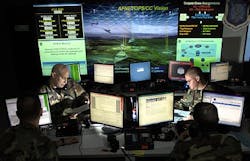DARPA picks six companies to define enabling technologies for U.S. cyber warfare strategy
ARLINGTON, Va., 11 July 2013. Information security experts at the U.S. Defense Advanced Research Projects Agency (DARPA) in Arlington, Va., have chosen six companies so far to define ways of understanding, planning, and managing military cyber warfare operations in real-time, large-scale, and dynamic networks.
DARPA has awarded six contracts collectively worth nearly $74 million for the Foundational Cyberwarfare (Plan X) project to conduct research into the nature of cyber warfare, and to develop strategies to seize and maintain U.S. cyber security and cyber attack dominance.
The contracts, awarded between 31 May and 1 July, are to Data Tactics Corp. in McLean, Va.; Intific Inc. in Peckville Pa.; Raytheon SI Government Solutions in Arlington, Va.; Aptima Inc. in Woburn Mass.; Apogee Research LLC in McLean, Va.; and the Northrop Grumman Corp. Information Systems segment in McLean, Va.
Data Tactics won a $25.8 million contract on 31 May, Intific won a $25 million contract on 13 June, Raytheon SI won a $9.8 million contract on 31 May, Aptima won a $6.6 million contract on 1 July, Apogee Research won a $5 million contract on 24 June, and Northrop Grumman won a $1.9 million contract on 27 June. More contracts may yet be awarded.
Cyberspace -- defined as a collection of computer networks using many protocols, as well as devices ranging from super computers to embedded systems -- is emerging as a new warfighting domain, DARPA scientists point out. As a result, the military is seeking to measure, quantify, and understand cyberspace.
Today's understanding of the cyber domain poses integration challenges with existing military capabilities, and connects computers using traceroute, packet analysis, and other techniques. In fact, current research is just beginning to answer questions about the cyber domain, DARPA officials say.
| Related stories -- Raytheon cyber maneuver technology to help safeguard Army networks from information attacks -- Stealing a drone by spoofing, is it that easy? -- Video: Air Force Cyber Command. |
The Plan X program contractors will define a cyber battlespace as three main concepts: network map, operational units, and capability set.
The network map is a collection of nodes and edges, and shows how computers are connected; the network map is where military planners and operators interact.
Operational units are platforms such as ships, aircraft, and armored combat vehicles that are part of the network topology. There are two primary types of operational units: entry nodes and support platforms.
An entry node gives direct physical access into a network, while support platforms control different aspects of an operation -- similarly to how military fighters, bombers, and unmanned aircraft a control different aspects of air campaigns.
The capability set involves technologies the military uses to control the cyber battlespace, and are divided into three categories: access, functional, and communication.
Access enables a user to run programs or payloads. Functional involves other types of technology that affect computers and networks, such as network scanners, denial-of-service, defense evasion, network and host reconnaissance, and operating system control. Communication helps entry nodes, support platforms, and system capabilities to exchange information.
The Plan X program seeks to integrate the cyber battlespace concepts of the network map, operational unit, and capability set in military cyber operations, and will be developed as an open platform architecture for integration with government and industry technologies.
The Plan X contractors are working on five separate technical areas to build a prototype system: system architecture, cyber battlespace analytics, mission construction, mission execution, and intuitive interfaces.
The system architecture team will build the Plan X system infrastructure and support overall system design and development. Cyber battlespace analytics will develop automated analysis techniques to assist human understanding of the cyber battlespace, support development of cyber warfare strategies, and measure and model battle damage assessment.
Mission construction will develop technologies to construct mission plans and automatically synthesize plans to an executable mission script. Mission execution will research and develop the mission script runtime environment and support platforms. Intuitive interfaces will design the overall Plan X user experience, including workflows, intuitive views, motion studies, and integrated visual applications.
The Plan X program is structured around an on-site collaborative research space (CRS) in Arlington, Va., where the program contractors will be organized as a virtual technology startup. Several contract awards are expected, and the program will run in four one-year phases.
For more information contact Data Tactics online at www.data-tactics.com; Intific at http://intific.com; Raytheon SI at www.raytheon.com; Aptima at www.aptima.com; Apogee Research at www.apogee-research.com; Northrop Grumman Information Systems at www.northropgrumman.com, or DARPA at www.darpa.mil.

